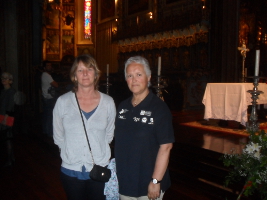
The intervention of conservation and restoration of the altarpiece and the stalls of the chathedral of Funchal was a joint project between several public and religious entities that received technical support from the Laboratory José de Figueiredo, through the restorative-conservative, Mercês Lorena, in the area of painting and Elsa Murta, sculpture and carving.
What is the importance of this altarpiece at a national level?
Mercês Lorena: It is important because it is the only one that remains in its original location, while on the continent in the various churches have been dismantled. This gives us the idea as how the altarpieces were at the time, mounted a structure of carving and painting. Moreover, before we could not see anything in terms of paintings and now has become a full, clean, original vision.
In terms of paintings, were different somehow, or important in the context of the time?
ML: In other altars that already no exist the paintings are in museums. In the Cathedral, in the chancel, are beautiful pictures, evangelical scenes, only here we have the complete picture, which are placed and read from left to right. The result in the end is excellent, the paintings are very good, they all show much of the original and still the withdrawals of the repintes was an asset, because everything was a group and it was rewarding.
Elsa Murta: And then we could see that the hoist is perfectly suited to the painting, was a common work. In the background is a royal order, of painting and carving, whose decorative motifs, carving small figures are placed in niches, have the same ethnographic evidence, that integrate, or decorate the whole of the altarpiece. We can understand that the technique is mixed, ie, is not what would see in Portugal at the time, but it is an order that, surely, was in foreign hands, which makes this Gothic aspect very flemish in the end, but it was also done by nationals.
I noticed that one of the paintings on the altarpiece was replaced in the third level.
MS: It is the last level, "ecco l'uomo" did not belong to the altarpiece, was later placed and fitted with hoist cut from an old dressing room of the Cathedral and it was taken in agreement with all parties involved in this project. There was a negative forms of architectural decoration that the altarpiece and has been decided to put a replacement. It is a new work, it has more to do with the office of the DRAC (Regional Directorate for Cultural Affairs), but it existed within the altar of consecration until recently a cross with Christ who was of the type of school Malim, is within that aesthetic, although we have no brand, possessed the size of what would be there and therefore, in accordance with made a new organization of the space. Within the ethnographic allegory makes sense to have been put in place, this episode lacked of Jesus on the cross, possibly because it was the calvary and there is registration and documentation at the time of the altarpiece, which described Christ in the center and St. John and the Virgin Mary laterally.
What is your personal view of this experience, of the restoration work?
ML: Especially teamwork. It is always good because everybody collaborates, brings new idea in conservation and restoration, people in this area cannot work in isolation, since the carving to painting, everything is an asset.
ML: It was good for the human knowledge of the professionals who are on the island and that worked very well together, but mostly alone, we did several regular trips to Madeira but mostly they worked alone. Are very skilled in professional and I also found that the methodologies we used 30 years ago is still very valid and resulted in a good finish work.










